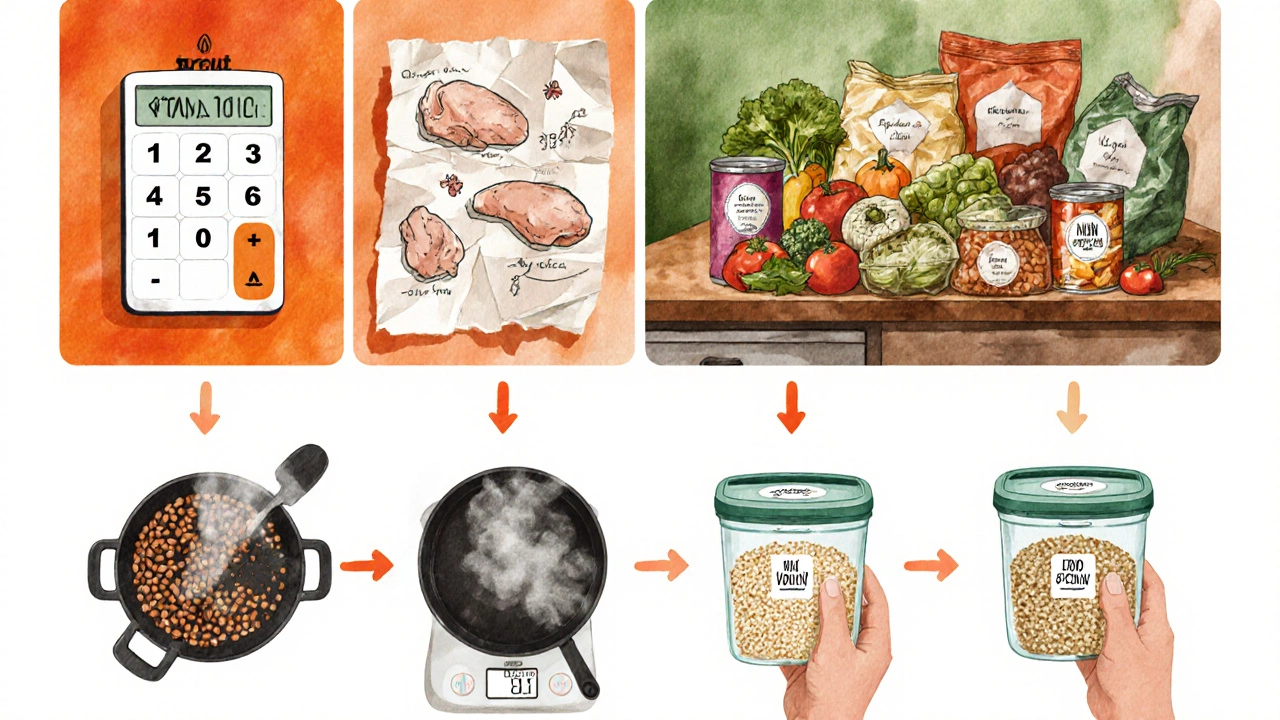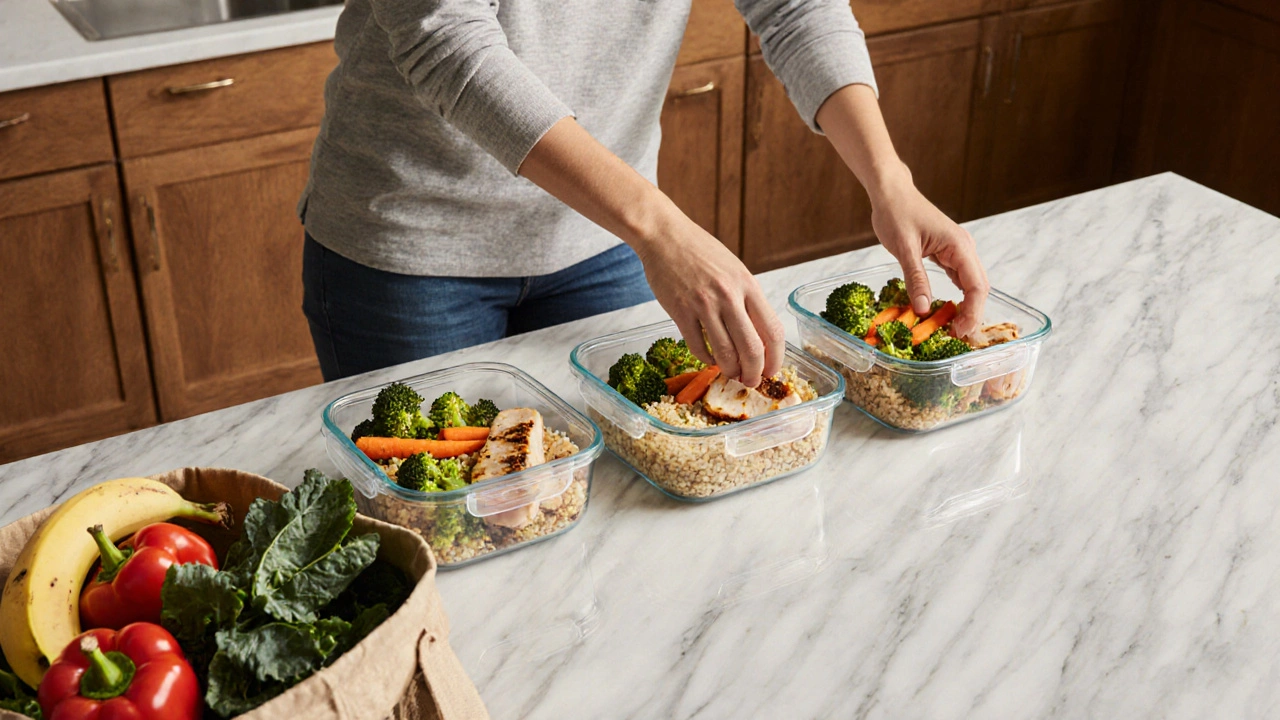Meal Prep Calorie & Macronutrient Calculator
Calculate your precise daily calorie target and macronutrient breakdown to create meal plans that support sustainable weight loss. This tool follows evidence-based principles from the article to help you build effective meal prep routines.
Key Takeaways
- Meal prep creates a built‑in calorie deficit by letting you control portions before you’re hungry.
- Choosing the right macronutrients (protein, carbs, fat) that match your activity level keeps energy steady and reduces cravings.
- Effective grocery shopping and food storage cut waste and lower costs, making the habit sustainable.
- A simple weekly checklist turns meal prep from a chore into a habit that supports weight loss.
- Avoid common pitfalls like under‑estimating calories, monotony, and improper food safety.
meal prep weight loss is a question many people ask when they feel stuck in a cycle of overeating or unhealthy take‑aways. The short answer: yes, you can lose weight with meal prep, but only if you combine it with the right strategy.
What Is Meal Prep?
Meal prep is the practice of planning, cooking, and portioning meals ahead of time, typically for a week. By deciding what you’ll eat before you’re famished, you remove the impulse to order fast food or graze on snacks. Meal prep doesn’t have to be gourmet; simple proteins, vegetables, and whole‑grain carbs can be mixed and matched.
How Meal Prep Influences Weight Loss
The core of any weight‑loss plan is a calorie deficit the state where you consume fewer calories than your body expends. Meal prep supports this in three ways:
- Portion control: Pre‑measured containers guarantee you eat the exact amount you intended.
- Consistent macronutrient balance: By designing each meal with protein, carbs, and fat, you keep blood‑sugar stable, which curbs hunger spikes.
- Reduced decision fatigue: When the choice is already made, you’re less likely to reach for high‑calorie “comfort” foods.
In addition, meal prep can subtly boost your metabolic rate the number of calories your body burns at rest because you’re more likely to include muscle‑preserving protein and fewer processed carbs that cause insulin spikes.

Step‑by‑Step Guide to Weight‑Loss‑Focused Meal Prep
- Calculate your target calories. Use a reputable calculator (e.g., Mifflin‑St Jeor) and subtract 500kcal for a safe 1lb/week loss.
- Plan balanced meals. Aim for 20‑30g protein, 30‑40g carbs, and 10‑15g fat per main meal. This ratio supports satiety and preserves lean mass.
- Make a focused grocery list. Include grocery shopping the act of buying food items in bulk based on a predefined list staples: chicken breast, canned beans, frozen veg, quinoa, oats, olive oil, and fresh fruit.
- Batch‑cook proteins and carbs. Grill a tray of chicken, steam a bag of mixed vegetables, and cook a large pot of quinoa. Portion each into individual containers.
- Invest in proper food storage. Use airtight glass containers (BPA‑free) and label them with the date. Good food storage methods that keep pre‑cooked meals safe for several days prevents spoilage and waste.
- Schedule a weekly prep day. Block 2‑3hours on a weekend; treat it like a workout. Consistency turns prep into a habit.
- Track your intake. Log each container in a nutrition app to ensure you stay within your calorie goal.
Common Pitfalls and How to Dodge Them
- Under‑estimating calories: Even healthy foods add up. Use a kitchen scale for accuracy.
- Monotonous meals: Rotate proteins (fish, tofu, turkey) and flavorings (herbs, spices) each week.
- Improper food safety: Cool cooked food quickly, store at <40°F, and consume within 4 days or freeze for longer.
- Skipping vegetables: Veggies add volume with few calories; aim for at least half your plate.
- Ignoring hunger cues: If you’re still hungry, add a low‑calorie snack like cucumber or a small fruit.
Meal Prep vs. No Meal Prep: Quick Comparison
| Factor | Meal Prep | No Meal Prep |
|---|---|---|
| Calorie control | High - pre‑measured portions | Low - prone to over‑eating |
| Time spent cooking | Front‑loaded (2‑3hrs/week) | Spread out (15‑30min daily) |
| Cost per meal | Lower - bulk buying | Higher - last‑minute take‑away |
| Food waste | Reduced - planned portions | Higher - unused ingredients |
| Nutrition quality | Consistent - balanced macros | Variable - impulsive choices |
Weekly Meal‑Prep Checklist
- ☑️ Review your calorie target and macro split.
- ☑️ Write a detailed grocery list based on the planned menu.
- ☑️ Shop for fresh produce, lean proteins, whole grains, and healthy fats.
- ☑️ Cook proteins (e.g., chicken, beans, fish) in bulk.
- ☑️ Prepare carb bases (quinoa, sweet potatoes, brown rice).
- ☑️ Roast or steam a variety of vegetables.
- ☑️ Portion everything into labeled containers.
- ☑️ Store in fridge (up to 4days) or freezer (up to 3months).
- ☑️ Log each container in your tracking app.
Frequently Asked Questions
Does meal prepping guarantee weight loss?
No. Meal prepping is a tool that makes it easier to stay in a calorie deficit. If you still eat more calories than you burn, weight loss won’t happen.
How many meals should I prep for a week?
Most people find 5‑7 lunch/dinner containers plus 2‑3 breakfast options works well. Adjust based on your schedule and appetite.
Can I lose weight if I only prep dinner?
Yes, dinner often contributes the most calories. Controlling that meal can create a noticeable deficit, but for best results manage all meals.
What’s the safest way to store pre‑cooked meals?
Cool food within two hours, use airtight glass containers, keep the fridge at 40°F (4°C) or lower, and consume within four days or freeze for longer storage.
Will I get bored eating the same meals?
Mix up sauces, spices, and protein sources each week. A simple swap-like swapping chicken for tempeh-keeps things fresh without extra prep time.
Ultimately, meal prep is a practical method to control the variables that matter for weight loss: calories, portions, and nutrition quality. Pair it with regular activity, adequate sleep, and a realistic mindset, and you’ll see the scale move in the right direction.
